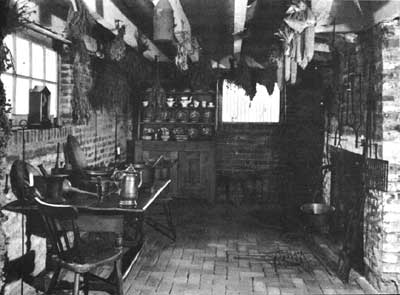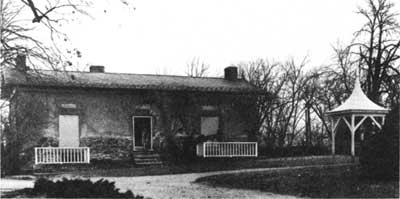|
CUSTIS-LEE MANSION The Robert E. Lee Memorial |
 |

The winter kitchen.
Guide to the House and Grounds (continued)
THE WINTER KITCHEN. The huge fireplace in the winter kitchen under the north wing helped to warm the rooms above during the cold months of the year. The portion of the room beyond the chimney was used as a laundry.
THE WINE CELLAR. A quarterly return from one of Mr. Custis' estates, dated 1822, lists "2 hogsheads of cider, 2 barrels of A[pple] Brandy" as having been sent to Arlington. It was probably stored in this cool, dark room, together with the scuppernong wine made from grapes grown along the edge of the garden north of the mansion. Here also were kept the choicer vintages used for entertaining.

The north servants' quarters and the well.
THE SERVANTS' QUARTERS. Two low buildings which harmonize architecturally with the main house form two sides of the court in the rear of the mansion. That on the north had a summer kitchen in the basement, its other rooms being occupied by the family servants. Perhaps because dampness made it unhealthy, the basement was filled in some years before 1861, but it is now restored to its original condition. The well between this building and the house is original, though the stone coping and roof are a restoration.
The corresponding building to the south was familiarly known as "Selina's House," because its western end was occupied by Mrs. Lee's personal maid, Selina Gray, and her family. The middle room was the smokehouse, and on the east end was the storeroom where nonperishable household provisions were kept. The small panels over the doors were originally painted by Mr. Custis, the one in the center depicting General Washington's war horse and the others, American eagles. Old photographs show similar panels decorating the north quarters, but these have long since weathered away.
THE GARDENS. The flower garden originally occupied the large level plot south of the mansion. Gravel paths divided the area into flower beds, and in the center stood a wooden arbor almost covered with yellow jasmine and honeysuckle. Mr. Custis had laid out the garden in his early years, but the responsibility for its care was soon assumed by Mrs. Custis, who loved flowers. Mrs. Lee acquired her mother's interest in gardening and had her own flower beds, while each of her daughters, as soon as they were old enough, were given small plots in which to grow their favorite blooms. Roses of different species predominated, the Cherokee being a favorite of Mrs. Custis', but there were also many other kinds of flowers and plants. It was the family custom to exchange seeds and plants with friends and relatives, thus adding to the variety of lovely blooms at Arlington.
North of the mansion, on the site of the present rose garden, was the "kitchen garden" where the vegetables used by the household were grown. Here were strawberry and asparagus beds, tomato vines and many other vegetables, as well as a number of fruit trees. The gardens were very important to the Lees, and in June of 1860 Robert E. Lee wrote to his daughter Annie, saying, "I was very glad to receive, my Sweet Annie, your letter . . . to hear that the garden, trees, and hill at Arlington looked beautiful The building at the north end is not an original structure, though it stands on the site of an earlier outbuilding.
THE GRAVE OF MARY RANDOLPH. The grave of Mary Randolph, believed to have been Mrs. Lee's godmother, is a short distance from the north east corner of the mansion, down the Custis walk which here approximates the course of the old carriage driveway. Mrs. Randolph was related to both the Custises and the Lees and was well known in the early part of the nineteenth century as the author of an extremely popular cookbook, The Virginia Housewife. She and her husband, David Meade Randolph, were often at Arlington, the latter being the inventor of a special waterproof stucco used on part of the exterior of the mansion. Mrs. Randolph died in 1828 and was the first person buried at Arlington. The ivy growing on the brick enclosure about her tomb is said to have been planted by Mr. and Mrs. Custis.
THE CUSTIS GRAVES. A few hundred yards southwest of the mansion Doubleday Walk passes a small plot enclosed by an iron fence. Here beneath the beautiful trees in the spot selected by Mrs. Lee are the graves of her mother and father. Colonel Lee ordered the marble monuments from New York, specifying that a wreath of lilies of the valley and heartsease should be carved on the one for Mrs. Custis' grave. He also supervised their erection.

|
|
Last Modified: Mon, Dec 2 2002 10:00:00 am PDT |


